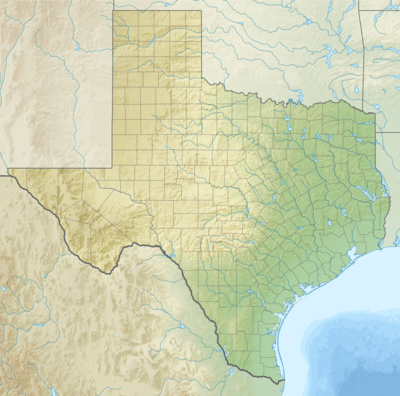San Antonio International Airport
| San Antonio International Airport | |||||||||||||||||||
|---|---|---|---|---|---|---|---|---|---|---|---|---|---|---|---|---|---|---|---|
 | |||||||||||||||||||
|
| |||||||||||||||||||
| Summary | |||||||||||||||||||
| Airport type | Public | ||||||||||||||||||
| Owner | City of San Antonio | ||||||||||||||||||
| Operator | San Antonio Aviation Department | ||||||||||||||||||
| Serves | Greater San Antonio | ||||||||||||||||||
| Location | San Antonio, Texas, U.S. | ||||||||||||||||||
| Hub for | Xtra Airways | ||||||||||||||||||
| Focus city for | Frontier Airlines | ||||||||||||||||||
| Elevation AMSL | 809 ft / 246 m | ||||||||||||||||||
| Coordinates | 29°31′36″N 098°28′19″W / 29.52667°N 98.47194°WCoordinates: 29°31′36″N 098°28′19″W / 29.52667°N 98.47194°W | ||||||||||||||||||
| Website |
sanantonio | ||||||||||||||||||
| Map | |||||||||||||||||||
 SAT Location of airport in Texas  SAT SAT (the US) | |||||||||||||||||||
| Runways | |||||||||||||||||||
| |||||||||||||||||||
| Statistics (2017) | |||||||||||||||||||
| |||||||||||||||||||
San Antonio International Airport (IATA: SAT, ICAO: KSAT, FAA LID: SAT) is an international airport in San Antonio, Texas, that serves the Greater San Antonio metropolitan area. It is located in Uptown Central San Antonio, about 8 miles north of Downtown. It has three runways and covers 2,305 acres (933 ha).[1] Its elevation is 809 feet (247 m) above sea level. SAT is located in class C airspace.
Overview
SAT averages 260 daily departures and arrivals at its 25 gates, which serve 12 airlines flying non-stop to 53 destinations. These destinations include 47 in the United States, five in Mexico, and one in Canada. The airport's top-ranked destinations are Dallas, Houston, Las Vegas, Chicago, Baltimore, New York, Los Angeles, Phoenix, Atlanta, and Washington, D.C.[3]
Airport officials produce a 30-minute news program about once every quarter. "Airport Airwaves" airs on Tuesdays at 9 p.m., Wednesdays at 11 a.m., and Fridays at 1:30 p.m. on the Government-access television (GATV) cable TV channel.
The longest flight (by flight time and distance) from San Antonio International Airport is to Seattle–Tacoma International Airport, a distance of 1,776 miles (2,858 km), with an average duration of 4 hours 7 minutes. This flight is operated by Alaska Airlines, and utilizes Boeing 737-800 and Boeing 737-900 aircraft.
The shortest flight from San Antonio International Airport is to Houston's George Bush Intercontinental Airport, a distance of 191 miles (307 km), with an average duration of 50 minutes. The flight is operated by United Airlines.
In 2014, the airport was ranked as the 44th busiest in the United States. It is considered a "medium hub" among U.S. airports, ranking just behind the Luis Muñoz Marín International Airport and ahead of the Southwest Florida International Airport. Airport passenger traffic was up 1.42% over 2013 to 8,369,628 passengers. Total domestic traffic had increased by 1.63% to 7,904,863 while international passenger traffic had decreased by 2.07% to 464,765 passengers.
The airport has been the busiest in South Texas. In 2017, more than 9 million travelers passed through San Antonio International Airport in 2017 — a record for the airport. It was ranked behind Texas airports at Dallas-Fort Worth (DFW and Love), Houston (Bush and Hobby), and Austin but ahead of El Paso.[4]
History
San Antonio International Airport was founded in 1941 when the City of San Antonio purchased 1,200 acres (490 ha) of undeveloped land that, at the time, were north of the city limits (now part of the city's Uptown District) for a project to be called "San Antonio Municipal Airport." World War II wartime needs meant the unfinished airport was pressed into federal government service. The airport opened in July 1942 as Alamo Field and was used by the United States Army Air Forces as a training base.
The 77th Reconnaissance Group, equipped with various aircraft (P-39, P-40, A-20, B-25, O-47, O-52, and L-5) trained reconnaissance personnel who later served overseas. One squadron (113th) flew antisubmarine patrols over the Gulf of Mexico.
At the end of the war the airfield was no longer needed by the military and was turned over to the City of San Antonio for civil use.
Terminal 2 was built in 1951–53, along with the FAA control tower and a baggage claim area. For HemisFair '68, a new satellite concourse was built, containing eight jet bridge gates and passenger waiting areas.
In 1975 the city adopted its first Airport Master Plan with plans for a new 1,300 space parking garage and a new 360,000 sq ft (33,000 m2) Terminal (formerly called Terminal 1, now called Terminal A). Once the new terminal was completed in 1984 it brought the airport's capacity up from eight gates to 27 gates. In 1986 a new 221-foot (67 m) FAA Air Traffic Control Tower was built at a new location.
In 1994 a second Airport Master Plan was developed that would take the airport well into the 21st century. This master plan included major updates for the airport. It called for more parking spaces made available through a new 3,000 space parking garage that would be completed by 2007. In addition it had plans for improved airport access, as well as an improved concession program. Two new terminals were planned to replace the aging Terminal 2, to increase the airports gate-capacity to 35.[5]
San Antonio closed the end of the 20th century with over 3.5 million passenger boardings in 1999. Since 1966, the airport has boarded more than 80 million people.
From February to September 2006, the airport was a focus city for United Airlines (the airline called it a "hublet") with flights to 12 cities in conjunction with their partner Trans States Airlines. Trans States Airlines redeployed their aircraft elsewhere, eliminating service to seven cities. Mexicana celebrated 50 years serving the airport in September 2007, but suspended service to San Antonio in August 2010 when the airline went bankrupt and suspended operations.
On November 9, 2010, the original Terminal 2 closed, and the Terminal B opened. Terminal 1 was then renamed Terminal A. The removal of fixtures in the old Terminal 2 began in January 2011. The final structural demolition of Terminal 2 took place in May 2011.
In 2013, the SAT Customs and Border Protection became a Global Entry enrollment center.
The airport is undergoing a major, multimillion-dollar expansion project which will add new terminals and parking facilities. The master plan for the project will increase gate capacity to 35. In addition, construction projects involving Interstate 410 and U.S. Highway 281 have improved access to the airport. (The airport sits near the northeast corner of the I-410/US 281 intersection.) Future plans also call for Stinson Municipal Airport, currently serving general aviation, to become the city's secondary commercial airport.
In January 2017, the airport began constructing a consolidated rental car facility. The 1.8 million square feet facility was planned to house up to 14 rental car brands and short-term public parking, and to eliminate the need for shuttles to remote rental car locations. The public parking portion was completed in April 2017. The rental car portion opened in January 2018.[6]
Terminals

San Antonio International Airport has two terminals with an overall 24 jet bridge gates. The original one-level terminal (formerly Terminal 2) opened in 1953 with ground-loading holding areas and was expanded twice, once in 1959 with new east and west wings, and again in 1968 with an eight-gate satellite concourse, which was built to handle visitors to HemisFair '68. Terminal 2 closed on November 9, 2010 as the new Terminal B opened, and Terminal 2 began to be demolished in March 2011, with completion in January 2012. A second terminal (formerly Terminal 1, now Terminal A) opened in 1984 with a 16-gate concourse. The U.S. Customs Federal Inspection Station (FIS) is located in Terminal A and is accessible from Gates A6-A9. Terminal A will soon begin going through an updating and modernization project.
Terminal A
Terminal A (previously Terminal 1) is the larger of the two concourses with 17 gates in total. All international carriers operate out of Terminal A. On June 18, 2014, a $35.6 million renovation was completed for this terminal, with the most visible improvements to passengers being new terrazzo floors, updated food courts, and new signage. On October 15, 2014, all gates in Terminal A were renumbered in sequential order.[7]
Eight carriers operate from Terminal A, with 15 of the 17 gates in use. Gate A17 also has a parking position designated as A17A that utilizes the same Jetway, The only difference is the parking position of the aircraft.
Gate A1 is mainly used for Delta charter flights but may also used for overflow Delta flights. Although listed on the Terminal map at the Airport's Website, Gate A16 is not a physical gate at the terminal.
Terminal B
Opened on November 9, 2010, Terminal B contains eight gates. Corgan Associates, Inc. and 3D/International designed the new terminal.[8] American and Continental were the two original airlines at Terminal B. United, at the time located in Terminal A, moved into Terminal B on August 1, 2012 during the merger with Continental. A United Club is located between gates B3 and B5. The USO is located on the bottom level of Terminal B next to baggage claim.
Gate B7 also has a parking position designated as Gate B7A that utilizes the same Jetway, The only difference is the parking position of the aircraft.
Located right between the very end of the Terminal and the taxiway, right beside Gate B8 is an old parking area designated as Parking bay "27". It is not in use.
Airlines and destinations
Passenger
Cargo
Statistics
Top destinations
| Rank | City | Passengers | Carriers |
|---|---|---|---|
| 1 | Dallas/Fort Worth, Texas | 504,000 | American |
| 2 | Atlanta, Georgia | 453,000 | Delta, Southwest, Frontier |
| 3 | Dallas–Love, Texas | 330,000 | Southwest |
| 4 | Houston–Intercontinental, Texas | 301,000 | United |
| 5 | Phoenix–Sky Harbor, Arizona | 270,000 | American, Frontier, Southwest |
| 6 | Denver, Colorado | 237,000 | Southwest, United, Frontier |
| 7 | Las Vegas, Nevada | 213,000 | Southwest, Allegiant, Frontier |
| 8 | Los Angeles, California | 203,000 | American, Delta, Southwest, United |
| 9 | Chicago–O'Hare, Illinois | 187,000 | American, Frontier, United |
| 10 | Houston–Hobby, Texas | 186,000 | Southwest |
| Rank | City | Passengers | Carriers |
|---|---|---|---|
| 1 | 236,086 | Aeroméxico, Interjet, Volaris | |
| 2 | 63,937 | Aeroméxico, Interjet | |
| 3 | 59,68 | Interjet, Volaris | |
| 4 | 29,76 | Southwest, United | |
| 5 | 1,869 | American, United, Southwest | |
| 6 | 1,232 | United | |
| 7 | 1,017 | American, United, Southwest | |
| 8 | 878 | United | |
| 9 | 826 | United | |
| 10 | 559 | American, United, Southwest |
| Carrier | Passengers (arriving and departing) |
|---|---|
| Southwest | 3,636,000(41.69%) |
| American | 1,718,000(19.70%) |
| Delta | 997,000(11.41%) |
| United | 912,000(10.46%) |
| Frontier | 366,000(4.20%) |
| Other | 1,093,000(12.53%) |
Annual Traffic
| Year | Total Passengers | % Change | International Passengers | % Change | Cargo | Percent Change |
|---|---|---|---|---|---|---|
| 2018 | 3,896,072 (Jan-May) | 148,014 (Jan-May) | 108,481,477 (Jan-May) | |||
| 2017 | 9,063,542 | 368,381 | 250,691,656 | |||
| 2016 | 8,618,139 | 400,061 | 238,056,389 | |||
| 2015 | 8,507,459 | 511,492 | 232,687,687 | |||
| 2014 | 8,369,628 | 464,765 | 233,333,939 | |||
| 2013 | 8,252,330 | 471,447 | 231,784,536 | |||
| 2012 | 8,243,221 | 421,718 | 258,339,049 | |||
| 2011 | 8,171,824 | 182,031 | 267,897,706 | |||
| 2010 | 8,034,720 | 136,970 | 272,951,743 |
Future
An expansion program began in 2006 to replace the original terminal (Terminal 2), add additional parking, and make roadway improvements. On November 9, 2010, Terminal 2 closed and the new Terminal B was opened. Terminal 1, in turn, was renamed Terminal A. The airport's master plan calls for another new terminal, Terminal C, to be constructed when it is needed; current estimates are that design work could begin in 2020. Preliminary plans for Terminal C call for five gates which could be expanded to 11 gates as passenger counts require. There are also long-range plans for a fourth terminal (Terminal D) which could have up to 20 gates, to be built as needed.
The existing bi-level roadway in front of Terminal 1 (Terminal A) was extended to provide service to the new terminals; the extension opened to traffic in November 2009. A 1,100,000-square-foot (100,000 m2) 3,000-space expansion to the existing five-level long-term parking garage was completed in mid-2008. Various ancillary utility projects and upgrades were also performed as part of this program.
On June 18, 2015, it was announced that the 3-story short-term parking garage, which was over 30 years old, would be closed and demolished in order to make way for a new 7-story parking garage and Consolidated Rental Car Center (CONRAC). In January 2018, the CONRAC facility opened for passengers with a grand opening by City Manager Sheryl Sculley and Major Ron Nirenburg. [24]
Accidents and incidents
- On January 31, 1967, a Saturn Airways DC-6 was operating on a cargo flight to Kelly AFB. The crew decided to divert to San Antonio International Airport and commenced the approach. The airplane descended 1,100 feet (340 m) below the glide slope, flew through trees and collided with a cliff. All 3 occupants were killed.
- On August 1, 2012, a bomb threat was made at 14:00 local time that resulted in one cancellation, three diverted flights and 28 delays. Nearly 2,000 passengers and staff personnel were evacuated onto the runway and into nearby high school buildings.[25]
- On October 29, 2012, Interjet Flight 2953, scheduled to Mexico City International Airport, made an emergency landing at San Antonio after suffering engine sputtering problems that was caused by a bird strike. No injuries or fatalities were reported.[26]
- On July 2, 2014, A Beechcraft Bonanza A36 suffered a Landing Gear Malfunction while on approach to the airport. The aircraft made many go-arounds and attempts to land on the runway with no gears. The pilot then notified the tower that the plane was running low on fuel and that the pilot was going to make the decision and land on the smaller runway 12L. The pilot then began to dump fuel to slow the aircraft down. The pilot then shut down the engine, shut off the propeller and landed on the runway with the aircraft's belly. Both passengers and the pilot made it out safely and without any injuries.
See also
References
- 1 2 FAA Airport Master Record for SAT (Form 5010 PDF), effective October 29, 2015
- ↑ "Financial Information & Statistics". City of San Antonio. June 2017. Retrieved September 24, 2017.
- ↑ "Nonstops". www.sanantonio.gov.
- ↑ "Calendar Year 2014 Passenger Boardings at Commercial Service Airports" (PDF). Federal Aviation Administration. p. 1. Retrieved November 19, 2015.
- ↑ "Vision 2050 A Flight Plan for San Antonio's Future" (PDF).
- ↑ San Antonio International Airport Opens New Consolidated Rental Car Facility
- ↑ "SAT". www.sanantonio.gov.
- ↑ "New Terminal B Opens at San Antonio International Airport - Clark Construction". www.clarkconstruction.com.
- ↑ "Flight Schedule". Retrieved March 30, 2018.
- ↑ "Flight Schedules". Retrieved March 30, 2018.
- ↑ "Flight timetable". Retrieved March 30, 2018.
- ↑ "Flight schedules and notifications". Retrieved March 30, 2018.
- ↑ "American Airlines Enhances 2019 Schedule". Retrieved October 2, 2018.
- 1 2 "Flight schedules and notifications". Retrieved March 30, 2018.
- 1 2 "FLIGHT SCHEDULES". Retrieved March 30, 2018.
- ↑ "Frontier Airlines".
- ↑ "Flight Schedule". Interjet.
- ↑ "Check Flight Schedules". Retrieved March 30, 2018.
- 1 2 "Timetable". Retrieved March 30, 2018.
- ↑ "Volaris Flight Schedule". Retrieved March 30, 2018.
- 1 2 "RITA | BTS | Transtats". Transtats.bts.gov. Retrieved September 20, 2018.
- ↑ "U.S. International Air Passenger and Freight Statistics Report". June 2017. Retrieved August 18, 2017.
- ↑ City of San Antonio Avidation Department. "Statistics – San Antonio International Airport". San Antonio International Airport.
- ↑ "CITY OF SAN ANTONIO" (PDF). www.sanantonio.gov.
- ↑ "San Antonio Airport Reopens After Bomb Threat". Airport International. August 2, 2012.
- ↑ Ley, Ana (October 29, 2012). "Plane makes emergency landing in S.A." Retrieved October 29, 2012.
External links
| Wikimedia Commons has media related to San Antonio International Airport. |
- San Antonio International Airport Website, official site
- San Antonio Intl Airport Group
- Resources for this airport:
- AirNav airport information for KSAT
- ASN accident history for SAT
- FlightAware airport information and live flight tracker
- NOAA/NWS latest weather observations
- SkyVector aeronautical chart for KSAT
- FAA current SAT delay information
- FAA Airport Diagram (PDF), effective October 11, 2018

